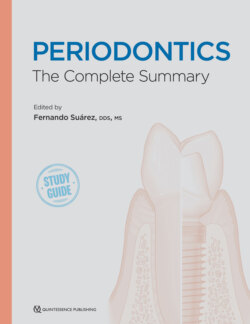Читать книгу Periodontics - Fernando Suarez - Страница 30
На сайте Литреса книга снята с продажи.
FURCATION INVOLVEMENT
ОглавлениеThe furcation is the anatomical area of a multirooted tooth from where the roots diverge and form bifurcation (two-rooted tooth) or trifurcation (three-rooted tooth).2 Furcation involvement or furcation invasion describes the pathologic resorption of bone within a furcation area1,2,20 (Fig 2-4). The Nabers furcation probe is widely used and suited for detection and examination of furcation involvement.2,20 The extent and configuration of furcation involvement can be characterized by anatomical factors including but not limited to presence of cervical enamel projections, enamel pearls, root trunk distance, tooth surface concavities, and the extent of root separation. The following summarizes the furcation entrances of multirooted teeth to aid in detection of furcation involvement20:
Fig 2-4 Furcation entrance on a mandibular first molar.
Maxillary premolar:Furcation involvement can be detected from the mesial or distal surface; the entrance is located at the apical third of the root and/or approximately 8 mm below the CEJ.
Maxillary molars:Buccal entrance: Centered mesiodistally.Mesial entrance: Two-thirds of the buccolingual width toward the palatal aspect, easier to approach from mesiopalatal aspect.Distal entrance: Furcation entrance is centered buccolingually and can be examined from either the buccal or palatal aspect.
Mandibular molars:Buccal entrance: Centered mesiodistally at the buccal surface.Lingual entrance: Centered mesiodistally at the lingual surface.
The amount of furcation involvement of a multirooted tooth can be registered depending on the horizontal and vertical amount of bony destruction into the furcation area.20–22 Many systems have been proposed for classifying furcation involvement.2 Hamp’s classification is one of the most commonly used for furcation destruction.22 A brief review of three systems is presented in the following sections.2,20–23
